Gents Trousers 101
Incredibly rough-and-ready guide to "that'll do the job" silhouettes of 19th century menswear.
(with the caveat that this is specifically a sort of generic, upper-middle, upper class white gentleman in the west; other fashions co-existed)
Menswear is typically neglected in historic stuff, for a variety of reasons - women's clothes have the "wow" - and besides, there isn't anything technically challenging about them which aren't also true of modern trousers. So a modern pattern that fits you, a sense of the right shape, and confidence - it fits my way of wanting to think about pattern making, as someone who can't use shop patterns. Making something like this with a viable method will look more-or-less-correct to all but the most discerning eye.
In all cases, the waist comes to the high waist on the body! You can rarely see the waistline so you want it safely above the height of your waistcoat.
1750s-1800
Tightly fitted knee breeches. This includes court dress, macaroni style, and some revolutionary-era menswear; and it continues to turn up well into the Regency as "old fashioned, therefore classy/high formality"

|

|

|
During/post the French Revolution, some styles came out as a response. The Incroyable was the decadent OTT outrageous panic attack trauma response style, still a tight knee breech but below the knee and tied with a little ribbon. Thigh-high striped socks are a must!


Meanwhile, the sans culottes - working people, associated with radicalism and the revolution - were named after what they wore, which is really rather recogniseable as the first trouser; shapeless and baggy, comfortable, easy to move in, easy to adjust:

Vincent notes that because the sans-culottes were associated with the revolution, Napoleon himself adopted them to wear on state occasions after he was made emperor (personal preference, or political savviness?). They also were in use by the French army, popularising them: "people thought that the manner in which a great conquering nation clad its legs was the correct model,and when the trouser-wearers marched over the wearers of pig-tails and knee breeches at Jena and Auerstadt [famous battles] a decision was given from which the world did not care to appeal".
1800-1830
One early Regency style is super freakin tight shapely leggings, like you ride horses in the military, for showing off your shapely thighs. If you do not have any, you can create some with padding. Think of this as the knee breech, but extended all the way down your leg or to the underknee like the incroyable; and notice the importance of accessorising with a military boot. Breeches as daywear exist up until ~1830, and are typically lighter in colour than the rest of the suit.
There's also pantaloons (1805-1830), which were made of a clinging knitted fabric, absolutely skin-tight on the leg. Not sure whether these pictures are technically a breech or a pantaloon, but I guess the distinction is whether it's a woven fabric that follows the shape of the leg, or a knitted fabric that looks sprayed on. My point is that for early 1800s, you wanna show off that leg.
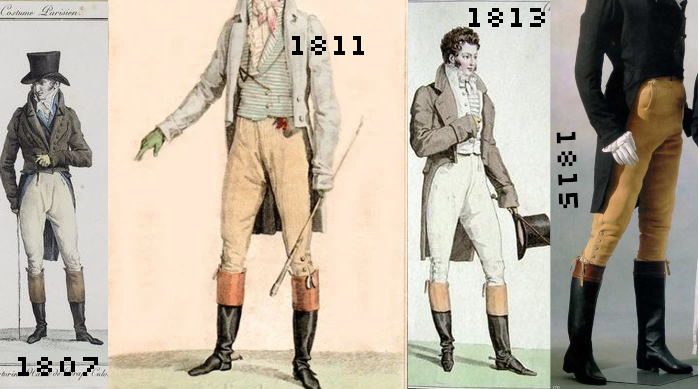
According to Vincent, pantaloons were something of a scandal as an innovation; they were banned at Oxford until 1810, Cambridge until after 1812, and the Duke of Wellington was banned from admission to Almack's in 1814 for appearing in his preferred pantaloons. By 1829, he adds, "pantaloons, or as we now call them trousers, were worn by almost everybody, exceot the delightful old-fashioned persons who stalk so peasantly through the pages of Dickens and Thackeray in their knee breeches and bag wigs".
(Not sure of Vincent's meaning when he says that pantaloons are the same as trousers; nor am I certain about the distinction between breeches or pantaloons. This is a vague guide to generic silhouettes!)
In the mid teens, real trousers start to break the mainstream - notice that the first one here is still shapely, moving towards more of a baggy look. Btw the trousers in this era, including the tight-fit ones, have super baggy butts so you can move. It's OK because it's hidden under the tails of your coat:

1820s-40s
1820s has this endearingly weird moment of very baggy and oval-shaped legs, sharply tapered and then wrapped under the boot with a strap. My copy of How to Read a Suit notes that some of these trousers would have 4"-6" extra on each side of the fronts, that were then pleated into place.
From the 1840s onwards, checked fabric and dark fabrics start coming into fashion, and the preference for pale trousers with a dark suit recedes
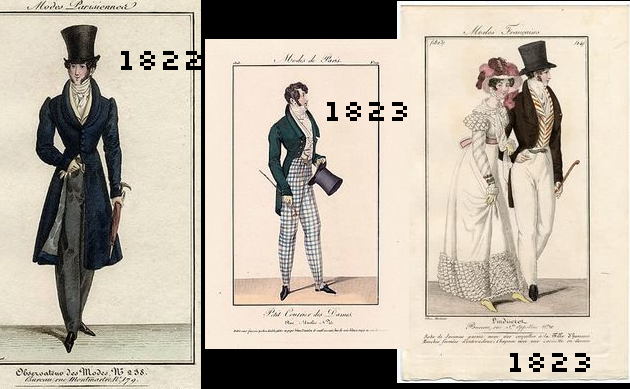
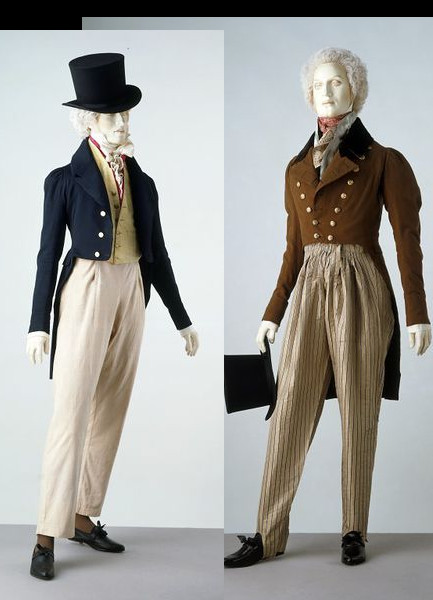
1850
Middle of the century saw the straight tubular trouser leg come into fashion - no ankle strap, and recogniseably a modern trouser. It also saw fall-front trousers go away for good, and the fly front come in (again, like a modern trew). Some even widened towards the ankle. Now, trousers of this kind had been known about for 50 years since the sans culottes & it's worth adding that like, not everyone dressed like a fashion plate. Given the versatility of real trousers, one presumes that working men had been wearing them throughout
I don't have any of these saved, but I've seen them about, and tbh they look a little scruffy and out-of-place. Just, a straight up-and-down trouser. Frankly, it looks a bit like a bad Victorian costume!
Fly fronts - Dia 1 - are basically like modern trousers; dia 3 & 4 were the norm before this decade.
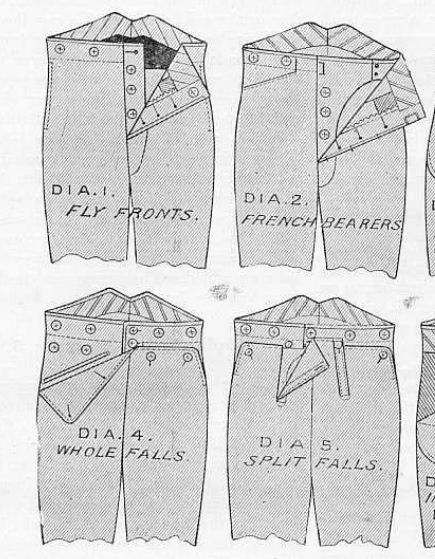
1860s-1890s
For the end of the decade, men's trousers look more or less like contemporary men's formal trousers, and so design details are tricky to eyeball on fashion plates and photos. They are high-waisted, and typically taper subtly towards the ankle, or fit closely from knee to ankle. For this era, you can very easily get away with a high-waist formal trouser pattern with a shapely leg.
Trouser creases begin to appear
At the start of the 1860s, the seat and thighs are still fairly loose, but towards the end of the period more darts and ironwork are used to make the fit around the butt and thighs sharp.
The further you get towards 1900, the more in fashion it becomes to have jacket, waistcoat and trousers all made from the same fabric, like a modern three-piece suit. Notice how the hem is cut on a diagonal over the boot - that's partly the way the hem is cut, but also the fabric is stretched and shrunk with the iron to subtly sculpt the shape of a leg, so the way it seems to curve towards the ankle will in part be that.
February 1868 Gazette of Fashion
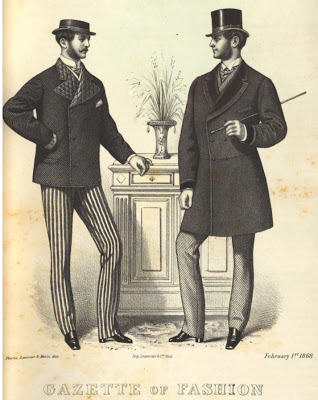
1870 - From “Gazette of Fashion, and Cutting-room Companion”
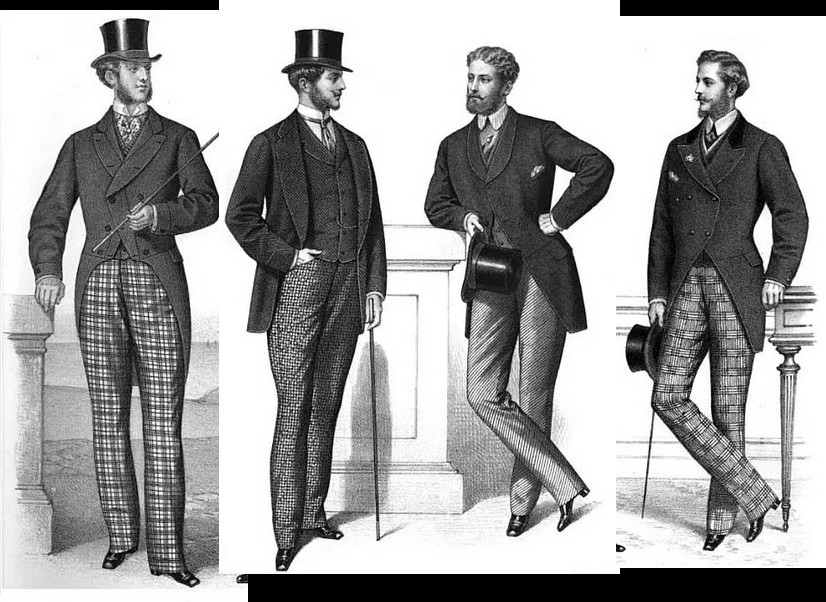
Ca. 1889-1890, J. Mitchell Co., New York, Fall-Winter

H. O'Neill & Co.'s Fall and Winter Catalogue, 1890-91 - to my eye, these seem to be cut more generously and wide-legged
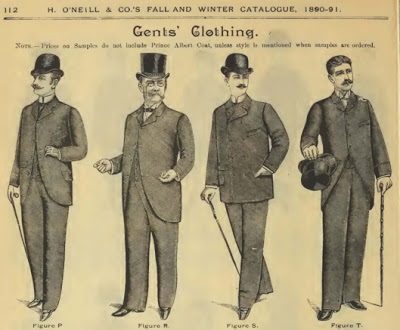
I did a big project to try and make a viable modern pattern out of Victorian tailoring legend WDF Vincent's pattern, and tl;dr is don't bother, his method is riddled with errors and anyone seriously suggesting you try it is a fool. Nevertheless, his book is still interesting for notes on styles and tailoring techniques. But it's maddeningly difficult to pin the Vincent texts available online down to a particular date. He won the Foundation prize for his essay on trouser-cutting in 1887; but the version of the book I have is from his 8th edition. To me, this reinforces the suggestion that between the 1880s-1910s, when Vincent was working, the modern trouser had essentially been invented, and modern tailoring basically all the same with slight fashion variants - but all in all, nothing changed so radically that Vincent went out of print.
Anyway, notice that curving inwards towards the ankle, created mostly by stretching the back of the lower-trouser-leg wool into a curve with the iron; and then a boot-shaped crescent cut into the hem.
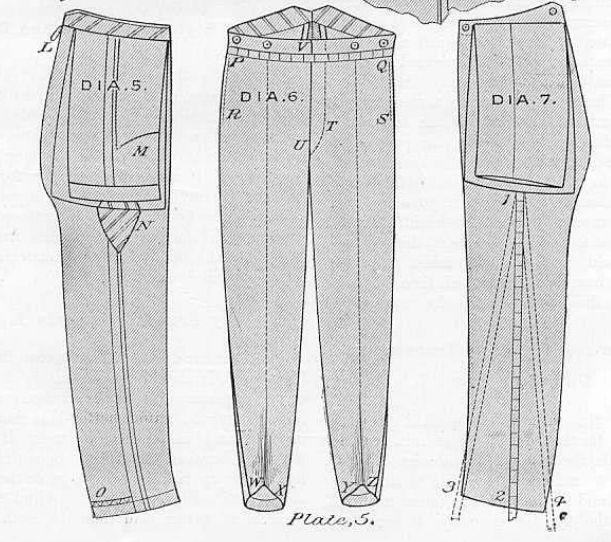
If you want to try this fancy iron trick, Vincent gives basic directions to where to stretch and shrink; and there's also modern instructions in the newest edition of Classical Tailoring Techniques by Cabrera
Vincent notes that different styles are popular with different people: French Bearers with the 'corpulent', easy fit seats for clergymen - who do a lot of sitting and writing, and in the East End "costers and pearlies" of Petticoat Lane (i.e. working class Londoners who made a living by selling eels), bell bottoms were in (Saville Row: 18 knee, 17 hem/Petticoat Lane: 15 knee, 22 hem). In other words, there is never a single style of trouser in fashion. He also gives instructions for breeches, which are still appropriate in some sporting and court/clerical/livery dress contexts (i.e. deliberately "old fashioned"):
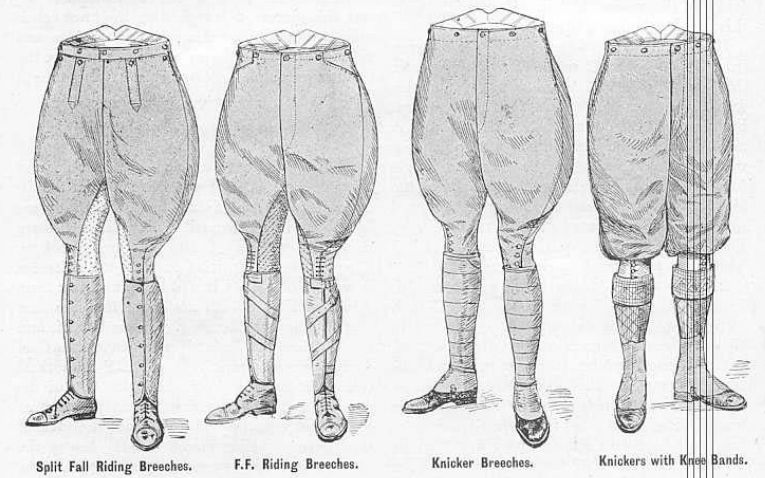
This is my favourite image due to its vaguely post-coital-satisfaction homoeroticism, but look at the swooping shape of the leg - narrow at the ankle and then widening gracefully towards the butt
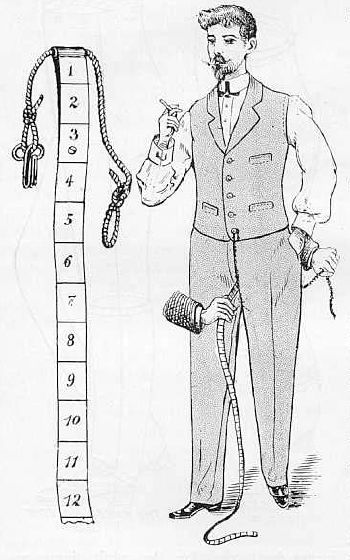
After 1900
A good place to consult is the Street x Sprezza vintage menswear guide:
A Very General Guide to Vintage: 1920s-50s
Sources
- How to Read a Suit - Lydia Edwards
- begrudgingly, The Victorian Tailor - Jason MacLochlainn
- The Cutter's Practical Guide to making all kinds of Trousers, Breeches etc - WDF Vincent
- My photo collection